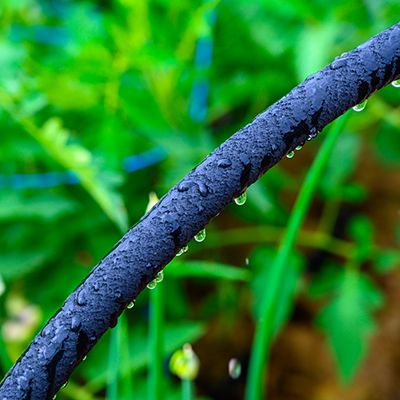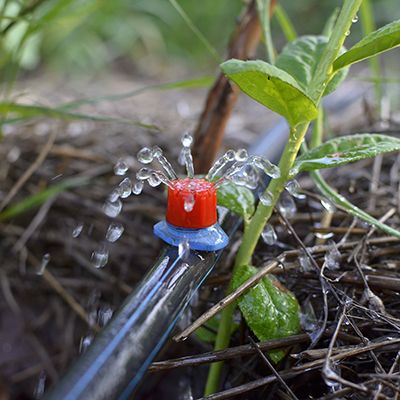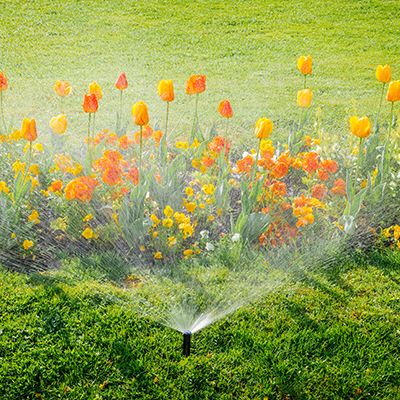


Irrigating Plants
GENERAL INFORMATION
More plants die from improper watering than for any other reason. Plants will die if they receive too little water while too much water can also be fatal.
Plants are living things and, the same as you, they need water to live. If there is too little water, the plant will become dehydrated and die. Symptoms of stress due to lack of water include browning of leaf tips, red foliage, leaf drop and wilting. Plants stressed for lack of water are much more susceptible to disease.
Too much water can lead to plant death in one of two ways. If there is so much water that the air spaces are filled, the plant literally drowns (the same as you would). The roots die from lack of oxygen (all the air spaces are filled with water) and with the roots dead, the plant will die.
A second reason for water related plant deaths is because of water molds. Water molds are always present in the soil and if there is sufficient moisture and a favorable temperature, the molds will proliferate and infect susceptible plants. Water molds will attack the crown or roots of susceptible plants. Infected roots turn black and die or the bark at the base of the stem loosens and peels off. In this case, the plant wilts and dies. Unfortunately, when people see the plant beginning to wilt, they often conclude the plant is dry and make the problem worse by giving it additional water.
Lawns, trees, shrubs, and perennials do not have the same water requirements and cannot be on the same watering schedule. (You cannot, for example, have the front of the house with a lawn, two trees and shrubbery on the same "clock").
Water must reach the root zone of a plant to be effective. Lawns will perform well if water penetrates four to five inches, perennials 8 to 10 inches, shrubs 12 to 16 inches and trees 18 to 24 inches. Drip systems and soakers installed one to two years ago will not be effective by the third year.
When trees, shrubs, perennials or annuals are first planted, they should be hand watered and soaked to ensure that water penetrates to the bottom of the root zone. Thereafter, spraying plants with a hose for 15 to 20 minutes in the evening is very therapeutic for the person but of little or no value to the plants. Instead, one of the irrigation procedures listed below should be used.
For plants growing in or near lawns, and which are wetted by the lawn sprinkler, the amount of water they receive is computed as zero.
TYPES OF IRRIGATION SYSTEMS
SOAKER HOSES
Soaker hoses are most effective for similar plants in a row or close together; i.e., hedges, foundation plantings, rows of vegetables, rose beds, etc. The soaker hose is laid out and pegged down between six and 16 inches from the base of the plants and may be run in a ‘U’ shape if the shrubs are large or there are two rows. If there is a row of shrubs and a tree at the end of the row, you could make one or two wraps around the tree at its drip line. The water is turned on so that
The hose just barely oozes water. Then, depending on the type of plants, the water is left to run for two to four hours determined by how deep you need to have the water penetrate. Do not water again until the top one-third of the watering zone has dried out (this prevents the growth of water mold).
As perennial plants grow, the hoses need to be moved further away from the base of the plant and the watering time and frequency adjusted. Well established hedges may need to be watered only once or twice per month - but a deep watering.
DRIP SYSTEMS
Drip systems are most effective for irrigating plants which are scattered over a moderate to large area such as ground cover shrubs several feet apart, a few trees near or in a lawn, perennials surrounded by organic or rock mulch, a grove of trees, or an artichoke in a lettuce patch. Drip emitters will release between one-half and five gallons of water per hour. The number of gallons emitted per hour is marked on each emitter. Determine how much water each plant needs as outlined in the last paragraph of the general information section above. Young plants will probably grow well with one emitter running at one gallon per hour once or twice a week. The second year, another emitter will be needed on the opposite side of the plant and eight to 14 inches from the base of the plant. By the third year, the emitters will probably have to be increased to two gallons per hour and moved out 18 to 24 inches from the base of the plant. When any irrigation system is adjusted, it is best to go out the day after watering the plants and dig down to determine how well the moisture needs of the plants are being met. Readjust the system if necessary.
After the third year, trees and large shrubs most likely need up to four emitters set near the drip line. The emitters should release two to five gallons per hour and be run for one to four hours once per week up to once a month.
LASER LINES
Laser lines are somewhat similar to soaker hoses with holes at six or 12 inch intervals. They will irrigate a finite distance of about 20 or 40 feet. Follow the same directions as outlined for the SOAKER HOSE.
SPRINKLER SYSTEMS
Sprinkler systems can be of the type which irrigates a large area such as a lawn or ground cover area or only an individual plant. Lawn sprinklers should have been installed so that there is a 100% overlap between adjacent sprinklers. The sprinklers have to be adjusted on an individual basis to ensure that the targeted plants are receiving the proper amount of water. Ideally, lawns should be irrigated for one half or one hour once or twice a week.
SOME OTHER CONSIDERATIONS
With a sprinkler system, fertilizers can be spread out over the area and then watered in. Foliage can be wetted to remove dirt and small insects. High humidity and wet leaves may encourage the growth of certain fungi.
When plants are root-bound or the soil in the container is packed quite hard, water may soak the soil amendment or backfill surrounding a newly planted tree or shrub but does not penetrate the root ball. Water will not move freely between soils of two densities. It was found by using the moisture meter the soil at the drip line to be moist but the soil in the root ball to be bone dry. Punching holes four to six inches deep and six to nine inches apart in the root ball will help to get the water into the plant.
Soaker hoses, laser lines, and drip systems can be buried or covered with mulch to be made inconspicuous. Fertilizers have to be applied in a liquid form (a short lived treatment) or pelleted fertilizers have to be hand watered after application. Plants are more susceptible to spider mites in a low humidity environment.
The Rapitest® Moisture Meter is a worthwhile investment to determine if your plants are receiving the correct amount of irrigation.
Please see our Container Plants Care Guide for additional information.